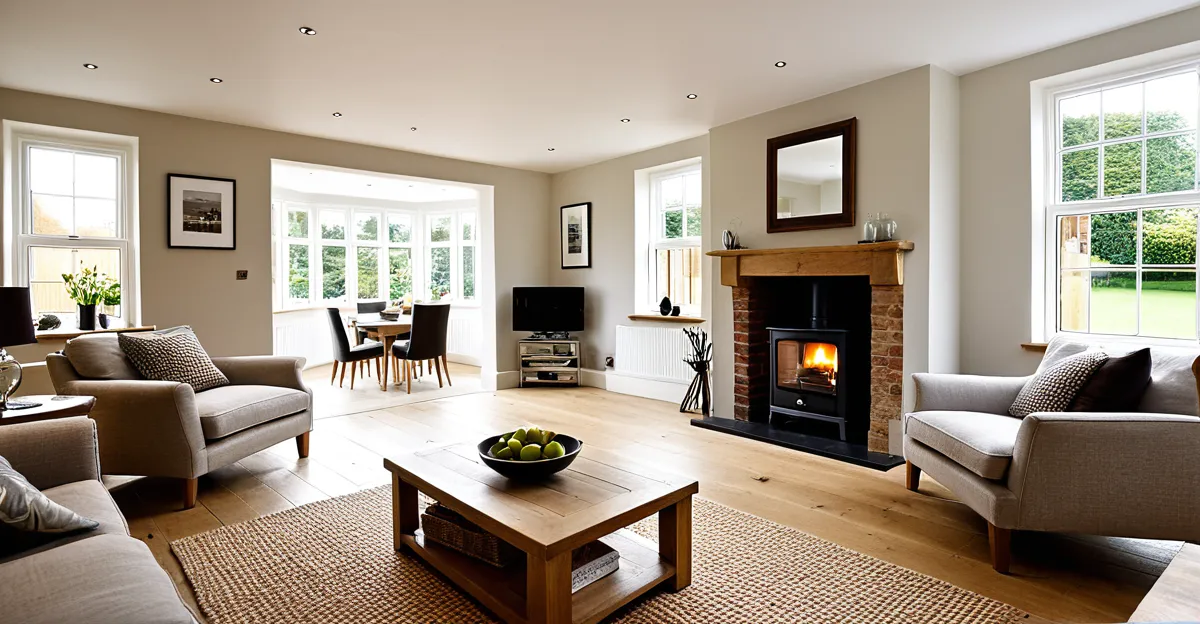Transforming a Traditional UK Home for Open-Plan Living
Creating an open-plan design in a traditional UK home demands thoughtful planning and careful execution. Many UK home renovations begin with the desire to bring together cramped, compartmentalized rooms into a seamless and flowing living space. The first crucial step in this home transformation is assessing which walls can be removed without compromising the home’s structure.
Before starting, homeowners must consider the existing layout and historical elements. It’s essential to identify walls that are non-load-bearing to open up spaces safely. Removing walls in period homes often requires consultation with professionals to ensure structural integrity is maintained. Engaging architects or structural engineers early in the process allows for detailed evaluations, minimizing risks during renovation.
Topic to read : How Can You Transform a Small Space into a Functional UK Home Office?
Essential tools and professional support greatly influence the success of the project. Depending on the extent of demolition and construction, access to cutting-edge equipment like laser levels or wall scanners can aid in accurately identifying elements within walls, such as wiring or pipes. Importantly, working with experienced builders familiar with traditional UK homes is key. Their expertise helps navigate challenges unique to older structures while achieving a modern open-plan feel.
By carefully planning these steps—assessing walls for removal, consulting specialists, and employing the right tools—homeowners set a firm foundation for transforming their traditional UK homes into versatile, elegant open-plan spaces.
Also to read : How can you maximize your garden space in a UK urban setting?
Structural Integrity and Building Regulations
Maintaining structural integrity is paramount during a UK home renovation, especially when removing walls to create an open-plan design. The first key step is accurately identifying which walls are load-bearing walls. These walls support the weight of the floors and roof above, and their removal without proper reinforcement can severely compromise home safety.
Engaging a structural engineer early in the project is essential. They assess the building’s framework and advise on necessary supports like steel beams or lintels to replace any removed load-bearing walls. This expert input ensures that the home transformation adheres to safety standards without undermining the property’s stability.
Complying with building regulations UK is another critical consideration. Before commencing demolition, homeowners must secure all required permits and approvals from local authorities. Building inspectors verify that any alterations meet current codes, including fire safety and structural requirements. Navigating these regulations can be complex, but thorough planning prevents costly delays or compulsory remedial works later.
In summary, the integrity of the home depends on careful planning around load-bearing structures and strict adherence to building regulations UK. Without these measures, an open-plan renovation risks hazardous weaknesses and legal complications. By combining specialist advice with compliant execution, homeowners achieve a safe, durable, and attractive open living space.
Blending Old Features with Modern Open-Plan Design
In a traditional UK home, preserving period features while embracing a modern open-plan design creates a unique and balanced aesthetic. Many homeowners want to retain elements like original fireplaces, intricate cornices, and decorative mouldings because these details embody the property’s character and heritage.
To answer the question: How can period features be preserved during an open-plan transformation? The key lies in careful planning and selective restoration. For example, original fireplaces can be retained as focal points within the new open space, rather than removed. Cornices and mouldings can often be repaired or even replicated where necessary, maintaining a sense of historical continuity.
Blending old and new involves integrating contemporary materials and finishes thoughtfully. For instance, sleek glass partitions or minimalist steel beams can contrast with traditional woodwork to highlight architectural details while supporting the open-plan layout. This technique allows for both practicality and style, ensuring that modern design enhances rather than overshadows the original features.
Moreover, enhancing character while achieving an open feel requires attention to proportions and flow. Retaining certain heritage elements within sightlines encourages a dialogue between the classic and the contemporary. Well-chosen lighting and colour palettes can further unify these contrasting aspects, making the space cohesive.
In summary, blending period features with modern design in heritage homes demands respect for original craftsmanship paired with innovative design solutions. This approach not only preserves architectural value but also creates open, inviting interiors that suit contemporary living.
Practical Design Solutions for Open-Plan Space
When planning open-plan layouts in a traditional UK home, one must carefully balance openness with functionality. The goal is to create a flowing space that still offers distinct zones for living, dining, and kitchen areas. This zoning helps maintain order without sacrificing the airy feel that defines an open-plan design.
How can distinct zones be created within an open-plan layout? The answer lies in using visual cues and spatial dividers rather than solid walls. Options include area rugs to define seating areas, strategically placed furniture, or partial-height partitions. These elements maintain openness while giving each zone a clear identity.
Maximising natural light is essential in UK interiors to enhance the sense of space. Removing internal walls allows light to travel freely, but careful window placement and using light-reflective surfaces further amplify brightness. Mirrors and glass features also support this effect, contributing to an inviting, spacious atmosphere.
Additionally, clever storage solutions and multifunctional furniture keep clutter at bay, essential for sustaining the clean lines typical of an open-plan design. This approach supports a sleek, modern aesthetic while respecting the traditional character of the home.
In summary, practical design solutions—including zoning techniques, strategic lighting, and smart storage—are key to successful open-plan living in UK homes. They allow homeowners to enjoy the best of both worlds: generous, interconnected spaces with purposeful, well-defined areas.
Challenges and Costs of Creating Open-Plan Homes
When undertaking an open-plan design in a traditional UK home, understanding the financial and logistical implications is crucial. A primary concern for many homeowners is the renovation costs UK associated with removing walls, structural reinforcements, and finishing touches. Typically, costs vary substantially depending on the extent of demolition, the need for specialist support, and the size of the project, but open-plan renovations often demand a significant budget allocation.
What are the typical expenses involved in an open-plan home transformation? The answer includes several major components: structural assessments by engineers, obtaining building permits, labour for removing walls safely (especially load-bearing ones), installing supports like steel beams, and the finishing work such as plastering and flooring. Unexpected challenges can increase costs, so a contingency fund is advisable.
Which common issues arise during these renovations? Project challenges often involve uncovering hidden problems like outdated wiring or damp within walls slated for removal. Delays due to weather, supply shortages, or regulatory approvals also impact timelines. Efficient project management and hiring experienced contractors mitigate these risks, helping maintain schedules and budgets.
Planning realistic timelines is essential. Open-plan renovations are rarely straightforward; a typical project may take several weeks to months depending on complexity. Factoring in extra time for design changes or unforeseen repairs ensures smoother execution.
In summary, successfully converting a traditional UK home into an open-plan living space requires budgeting thoughtfully for renovation costs UK, anticipating obstacles, and allowing flexibility in timelines. This foresight supports a rewarding and well-managed UK home renovation experience.
Real-Life Examples of Open-Plan Transformations in the UK
Examining UK case studies of open-plan transformations offers valuable insights into the practical aspects of home renovation. One notable example involves a traditional UK home in a conservation area where the owners aimed to retain charming period features while creating an airy, cohesive space. They began by carefully removing walls identified as non-load-bearing, allowing for a dramatic flow between the kitchen, dining, and living areas without sacrificing heritage elements.
These real-life projects often reveal common hurdles encountered during home transformation. For instance, one homeowner discovered unexpected timber decay behind a wall slated for removal, necessitating additional structural repair. Such surprises emphasize the necessity of thorough inspections and flexible budgeting to accommodate unforeseen issues.
A useful lesson from UK homeowners is the importance of engaging experienced professionals early. Structural engineers ensured that all load-bearing walls were properly supported, while builders skilled in handling older properties preserved delicate mouldings and fireplaces. The collaborative approach contributed to efficient progress and compliance with building regulations UK.
Before and after photos from these case studies highlight how well-thought-out layouts and smart design choices can breathe new life into traditional settings. By integrating modern open-plan ideas with respect for original architecture, the renovations achieved both functionality and aesthetic charm.
In summary, UK home renovation examples demonstrate that strategic planning, skilled support, and adaptability are key to overcoming challenges and successfully executing open-plan home transformations.





